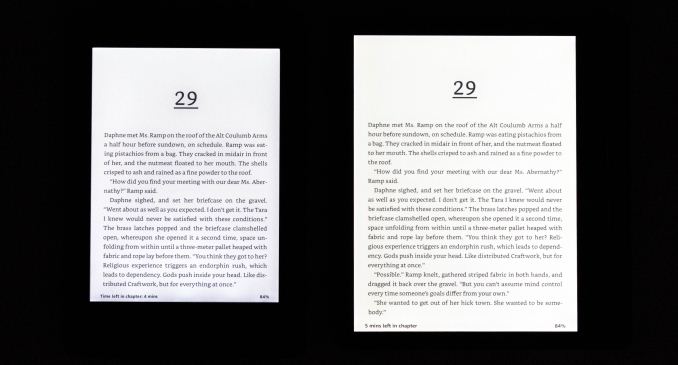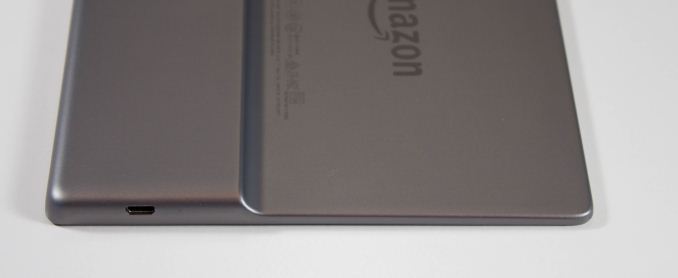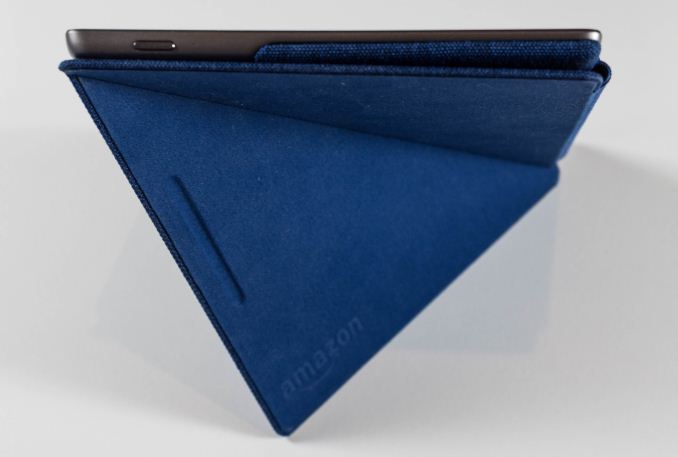The Amazon Kindle Oasis (2017) Review: A Premium Take On The E-Reader
by Brett Howse on January 25, 2018 8:00 AM EST- Posted in
- Accessories
- Amazon
- Kindle
- e-ink
- E-Reader
- Kindle Oasis
Reading with the Kindle Oasis, & Final Thoughts
We’ve gone over how the new Kindle feels in the hand. We’ve looked at how the new, larger display compares to previous Kindles and the current generation. But how does it work as an E-Reader?
As a Kindle customer for a long time, it’s taken a bit to get used to the new design. The way you hold a Paperwhite is not the same way you hold an Oasis, thanks to the asymmetric design, and it’s taken over a month to get used to holding the book on the side. I had previously always held them on the bottom, which sounds like a small thing, but it was a big change for my muscle memory. After a couple of months, it feels more natural now, and now using the Paperwhite seems a bit strange. If you wanted to hold it on the bottom you can just flip the orientation of the text in settings and hold it in landscape. I did try this, although the screen was almost too large for landscape, and my eyes had to move too much to get to the end of a line. Once again, muscle memory. After a couple of months, the feel of the Oasis has grown on me, and the benefit of holding it with one hand, which also can hit the page turn buttons, works very well.
One thing you do notice right away is the reduction in weight. The Oasis, despite its larger dimensions, is lighter in the hand, and that reduction in weight is magnified by the larger size, and the design. Since most of the weight is in your hand, rather than spread out evenly across the device like a Paperwhite, the Oasis feels much lighter than the Paperwhite. Fatigue from long reading sessions is reduced.
The larger display is fantastic as well. You can fit more text on the page, so page turns are reduced, but when you do need to turn a page the new processor gets the job done much more quickly than the Paperwhite. Thanks to the thinner bezels on three of the sides, the larger display doesn’t feel like it makes the Oasis much bigger than the Paperwhite either, although it is an entire inch wider.
The new 12 LED lighting system has also been a treat. The Paperwhite does fine, but there’s some unevenness to the brightness. The Oasis has a very uniform display, and the added features of automatic brightness are handy, although not always wanted. Luckily you can disable the overall automatic brightness, but leave the automatic dimming enabled, so you can read in the dark and the display will drop the brightness over time.
 Kindle Paperwhite (left) vs Kindle Oasis (right) in the dark
Kindle Paperwhite (left) vs Kindle Oasis (right) in the dark
There’s other E-Readers on the market, but if you’re in the market for a Kindle, you’re likely after the Amazon ecosystem, so the Oasis really needs to compete against the rest of the Kindle lineup. The $80 base Kindle should be ignored. The lack of lighting is a real detriment to it, and it has the lowest resolution E Ink display of the lineup, at 167 PPI. If you’re after a Kindle the Paperwhite is likely your best starting place. Amazon lists it at $119.99, but it’s often on sale for $99.99. Even at $40 more than the base Kindle, I think it’s worth it, but if you can get it on sale, it’s well worth the $20 upgrade. You get lighting, and you get a higher resolution display.
The Voyage sits in a strange middle ground now, and what used to be the top-of-the-line Kindle now costs $80 more than the Paperwhite, but isn’t the top of the line model. It has the same 6-inch display as the Paperwhite, although it increases the LEDs from 4 to 6, and has adaptive brightness. It’s also 30 grams lighter than the Paperwhite, and has page-press buttons like the Oasis. It feels like it’s a steep premium over the Paperwhite, for a nicer model that’s not quite the best Amazon has to offer.
The step up to the Oasis adds a lot of features, but also quite a bit to the price. At $249.99, it’s over twice the price of a Paperwhite, and over three times the price of the base model. If you go for the larger capacity model, add cellular, and don’t go for the “Special Offers” advertising, the max price Oasis is a staggering $349.99. That’s easily quality tablet territory, and is an awful lot for a niche device like a Kindle.
The Oasis does add a lot of functionality though. The larger display is fantastic, as is the better lighting. The addition of Bluetooth support means you can use the Oasis to play back audiobooks. The IPX8 rating means you can drop it in the pool and it will still work, which is not something you can say of any other Kindle.
To me, my Kindle Paperwhite is likely one of the best pieces of technology that I own. It’s rare to get a device that is so good at what it’s designed for. Being designed for just one task lets the device be perform very well at that task, and for me, an single-use device is appreciated. Reading on a tablet or a smartphone is just not as enjoyable, thanks to the LCD display, and the distractions of a smartphone.
Another advantage of the Paperwhite is that the price, at close to $100, makes it a much easier to replace item. If you’re a person that sometimes forgets their Kindle in the pocket of an airline seat, you probably will want to steer clear of the much more expensive Oasis. I wouldn’t call the Paperwhite disposable, but it doesn’t hurt as much if you do lose it or break it.
This is the dilemma with the Kindle Oasis. It’s very nice to use. It has a fantastic display. The aluminum feels great in the hand. But it is twice the price of a Paperwhite, and I love my Paperwhite. The Oasis starts at $130 more than a Paperwhite, and that's a lot of books. But, If you really enjoy reading, and the price doesn’t bother you, the latest top-end Kindle is a fantastic reading device, and you’d have a hard time finding a better E-Reader.












93 Comments
View All Comments
vanilla_gorilla - Thursday, January 25, 2018 - link
That cost difference is completely negligible considering how much time I spend reading on a kindle. I went from a paperwhite to an oasis and it's been great. You can disable the infernal touch screen so that only the three physical buttons work (page forward, back and power to lock and re-enable the touch screen). I can't tell you how many times my finger accidentally made it a millimeter onto the touchscreen on my paperwhite and caused a page turn. Then as I poked at it angrily to flip back, I turn another page the wrong direction.Anyway, I couldn't be happier, display is beautiful and the device feels great and has tons of great features my paperwhite didn't have, but I would have paid the difference just on the quality of the device, display and tactile buttons.
Scrote - Thursday, January 25, 2018 - link
Typo here:"The 2017 Oasis adds some nice features over it’s lower brethren though."
over it is lower brethren? :)
prateekprakash - Thursday, January 25, 2018 - link
Is it possible to read PDF created by us on the display?In that case Kindle would be useful to me that I would be able to read my notes.
DanNeely - Thursday, January 25, 2018 - link
My 6 year old Kindle can read PDFs so I'd assume new ones can too.The main limiting factor in doing so though is that it can't reflow them to fit better on the small screen. Unless newer models can do that reading PDFs designed for a standard letter/a4 page will have uncomfortably small text in many cases unless you want to be scrolling left/right to read each line of text.
mode_13h - Friday, January 26, 2018 - link
For PDFs, check out the Kobo Aura ONE, with a 1872x1404 7.8" screen, using the same 300 dpi e-ink technology as this Kindle. That's almost the same vertical resolution as you get on a 4k monitor.Brett Howse - Friday, January 26, 2018 - link
Assuming you don't have a lot of graphics in your PDF, the best way to do this is to use the Amazon service to send it to your Kindle, and their service will OCR it and convert it into an e-book so the text can reflow.KLC - Thursday, January 25, 2018 - link
I read reviews like this and comments like the ones just made and wonder why the ereader experience hasn't grabbed me. I read a lot, multiple books a week. I once tried a kindle and I agree that reading on an LCD device like a phone or iPad doesn't compare to e ink. It really is just like reading print. I want to use a kindle, to have multiple books on one small but good device. So why don't I? It's the ebooks, I find almost all of them to be terrible, poorly designed, poorly executed, ridden with errors, lacking what is available in printed editions. I love kindles but I hate ebooks.DanNeely - Thursday, January 25, 2018 - link
What're you using as your ebook source, and what are you trying to read? With the exception of some really old files (I've got some decade+ old files from when a publisher was giving away free samples for promotional purposes) I haven't had formatting/quality problems with any new release commercial fiction ebooks I've bought from a major publisher.Stuff I've gotten from the Gutenberg Project's been a lot more hit and miss. Raw scans or ones that appear to've only had someone go through and fix the worst of the scanning errors are going to be awful.
The only category I still generally prefer print for is non-fiction with maps/charts/etc because there's no kindle equivalent to a half dozen bookmarks stuffed in various locations so I can quickly flip to the non-text information as needed and then back to where I'm reading.
KLC - Thursday, January 25, 2018 - link
I agree that current fiction titles are fine, I should have added that much of what I read is non-fiction with charts, graphs and especially endnotes. Many ebooks seem to be done as unthinking, poorly planned replications of text, as if 99% of the work went in to the book and then they told an intern to take the afternoon and port it to an ebook to capture some extra dollars. There seems to be little focus on ebooks as a unique product that take advantage of electronic text.And what you say about Gutenberg kind of illustrates what I would love to have a Kindle for and why I find ebooks so lacking. I'd love to have a library of classic literature, the books I want to read someday but never get around to. But I've been constantly disappointed with the quality of those kind of books. I'm willing to pay but I find that many of the paid versions as lacking as the free versions. You type in a title in Amazon, say Don Quixote, and you get dozens of versions, some paid, some free. How do you successfully weed out the poor ones without making it a day's work of downloading and sampling each one? I'd love to have a source of classic lit ebooks that has consistent quality of design and execution.
robinwhittleton - Thursday, January 25, 2018 - link
I contribute to the Standard Ebooks project and that does everything you’re asking for: takes Gutenberg sources and makes high quality ebooks from them.